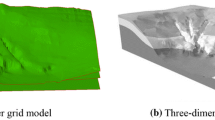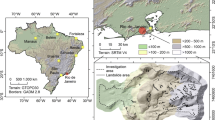Abstract
Deterministic stability models are used to assess the potential for mass movement within Hamilton City, New Zealand using sensitivity analysis for critical environmental variables. Discrete geomorphic zones are recognised on the basis of material properties and slope characteristics; generic slope profiles are derived for each of these zones by averaging slope profiles determined from a Digital Elevation Model. Stability analysis models are used to derive critical failure surfaces for these profiles using measured or estimated material properties, and sensitivity analysis allows the conditions of water table level and seismic acceleration under which the slopes become unstable to be determined. This method is applied to Hamilton City to assess the citywide hazard associated with mass movement. For the slopes studied, conditions of elevated water table alone may initiate failure, but this is seen as unlikely as the materials are well drained. Combinations of water tables above 10% of the slope elevation together with seismic accelerations of approximately 0.2 g (150 year return period) represent likely failure conditions for many slopes. This information provides emergency management planners with estimates of the likely extent of failure in different regions of the city, and hence facilitates identification of lifelines and infrastructure at risk. The method cannot provide site-specific information, but in combination with knowledge of cultural features gives indications of critical locations where detailed engineering assessments are required.
Similar content being viewed by others
References
Al-Homoud, A. S. and Tahtamoni, W.W.: 2001, A reliability based expert system for assessment and mitigation of landslides hazard under seismic loading, Natural Hazards 24, 13–51.
Blackstock, H. A. I.: 2002, Hazard mapping in Hamilton City, New Zealand, M.Sc. thesis lodged with the University of Waikato, Hamilton, New Zealand, 438 pp.
Clover Technology: 2001, GALENA Version 3 for Windows. Slope Stability Analysis System. Users' Guide, Clover Associates Pty Limited, Australia, 103 pp.
Craig, R. F.: 1997, Soil Mechanics, 6th edn, Spon, London, 485 pp.
Crowcroft, G. M.: 1992, A Groundwater Investigation of the Mangaonui/Mangaone Catchment, Hamilton Basin, M.Sc. thesis lodged with the University of Waikato, Hamilton, New Zealand, 142 pp.
Koloski, J. W., Schwarz, S. D., and Tubbs, D. W.: 1989, Geotechnical Properties of Geologic Materials, Engineering Geology in Washington, Vol. 1, Washington Division of Geology and Earth Resources Bulletin 78.
Hodder, A. P. W. and Moon, V. G.: 1994, Seismic Risk to Underground Services, Hamilton City, Department of Earth Sciences, The University of Waikato, 27 pp.
Hoek, E.: 2000, Practical Rock Engineering, 2000 edition, Online resource: http://www.rockeng.utoronto.ca/roc/Hoek/Hoeknotes2000.htm
Maunder, W. J.: 1974, Climate and Climatic Resources of the Waikato, Coromandel, King Country Region, New Zealand Meteorological Service miscellaneous publication No. 115, 29 pp.
McCraw, J. D.: 1967, The surface features and soil pattern of the Hamilton Basin, Earth Science Journal 1(1), 59–74.
Microsoft: 1998, Encarta World Atlas, 1998 edition.
climate_summaries.asp 30/08/01
Pryce, T. V.: 1997, Distribution and geotechnical properties of Quaternary volcanogenic deposits and soils, Flagstaff North, Hamilton, New Zealand, M.Sc. thesis lodged with the University of Waikato Library, Hamilton, New Zealand, 219 pp.
Selby, M. J. and Lowe, D. J.: 1992, The middle Waikato basin and hills, In: J. M. Soons and M. J. Selby (eds), Landforms of New Zealand, 2nd edn, Longman Paul, Auckland, pp. 233–255.
Smith, W. D. and Berryman, K. R.: 1986, Earthquake hazard in New Zealand; inferences from seismology and geology, Royal Society of New Zealand Bulletin 24, 223–243.
Stirling, M., Wesnousky, S. G., and Berryman, K. R.: 1998, Probabalistic seismic hazard analysis of New Zealand, New Zealand Journal of Geology and Geophysics 41, 355–375.
Stirling, M., McVerry, G. H., and Berryman, K. R.: 2002, A new seismic hazard model for New Zealand, Bulletin of the Seismological Association of America 92, 1878–1903.
Unpublished course laboratory reports: 2000–2001, Course 0772.351Y Engineering Geology, Department of Earth Sciences, The University of Waikato, Hamilton, New Zealand.
Wu, T. H.: 1996, Soil strength properties and their measurement, In: A. K. Turner and R. L. Schuster (eds), Landslides: Investigation and Mitigation, Special report 247, Transportation Research Board, National Research Council, pp. 319–336.
Wu, T. H. and Abdel-Latif, A.: 2000, Prediction and mapping of landslide hazard, Canadian Geotechnical Journal 37, 781–795.
Author information
Authors and Affiliations
Rights and permissions
About this article
Cite this article
Moon, V., Blackstock, H. A Methodology for Assessing Landslide Hazard Using Deterministic Stability Models. Natural Hazards 32, 111–134 (2004). https://doi.org/10.1023/B:NHAZ.0000026793.49052.87
Issue Date:
DOI: https://doi.org/10.1023/B:NHAZ.0000026793.49052.87




